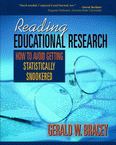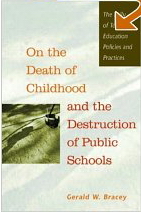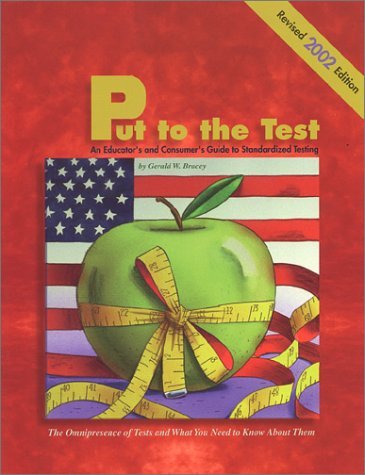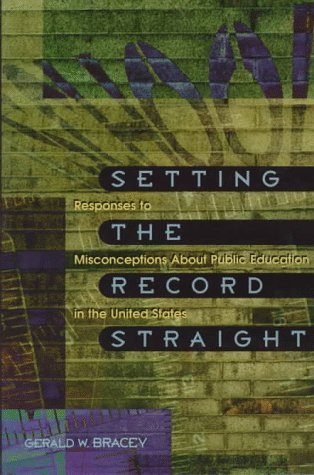Background: “Nationally known policy analyst, researcher and author Gerald Bracey loves to separate public education myth from reality in his lectures and writings. Bracey, a Virginia native, is well known for his monthly educational research columns in Phi Delta Kappan, and his periodic ‘Bracey Report on the Condition of Education’ has drawn the attention of national media. His article ‘Why Can't They Be Like We Were?’ now known as ‘The First Bracey Report,’ drew the wrath of the first Bush Administration for Bracey's refutation of statements made in A Nation at Risk, a national education report commissioned by then President Bush. Bracey has been a research psychologist for the Educational Testing Service, associate director of the Institute for Child Study at Indiana University-Bloomington and served for nine years as the director of research, evaluation and testing for the Virginia Department of Education. Bracey emphasizes he does not believe schools are perfect. ‘There are real problems,’ he says, ‘but there needs to be a fuller discussion of those problems, and we need to get past the misconceptions.’” — From SpeakersRus, Huffington Post Bio.
“Gerald W. Bracey, 69, one of the most erudite, prolific and acidic critics of national education policy, died unexpectedly early Oct. 20 at his home in Port Townsend, Wash.” Jay Mathews, Washington Post, 10/23/2009. USA Today obituary, Generation YES blogs: 1, 2.
Gerald Bracey's EDDRA WEBSITE: [HuffingtonPost Description]
Education Hell: Rhetoric vs. Reality 288 pages, pb. June, 2009.
Book Description:
Are America's schools in crisis? Are they broken beyond repair? In Education Hell: Rhetoric vs. Reality, Dr. Bracey makes a convincing argument while there is certainly room for improvement, public schools are as good as or better than they've ever been. By too easily accepting a credo of “what can be measured matters,” many have accepted misconceptions about our students' progress as well as their standing among the world's children. Educators will find this book uplifting and convincing. Critics will be forced to pause and reconsider. School leaders will be thrilled to get the facts needed to counter widely held misconceptions among parents, community members, business leaders, and even some of their own employees!
The growing impact of international competition, the debilitating effects of poverty, the many facets of intelligences, the teaching of character and citizenship, the foundation needed in secondary school to prepare students for college graduation, and more are presented in a thought-provoking fashion. Education Hell: Research vs. Reality will make an excellent book study for school leaders and the conversations created not unfounded criticisms will move us forward on the journey toward better schools.
Reading Educational Research: How to Avoid Getting Statistically Snookered 188 pages, pb. Feb, 2006.
Here are Bracey's 32 principles of data interpretation. Schield grouped these into eight categories.
- Do the arithmetic
- Show me the data
- Look for and beware of selectivity in groups
- When comparing groups, make sure the groups are comparable
- Be sure the rhetoric and the numbers match.
- Beware of convenient claims that, what ever the calamity, public schools are to blame.
- Beware of simple explanations for complex phenomena.
- Making certain you know what statistic is being used when someone is talking about the “average.”
- Be aware of whether you are dealing with rates or numbers. Similarly, be aware of whether you are dealing with rates or scores.
- When comparing rates or scores over time, make sure the groups remain comparable as the years go by.
- Be aware of whether you are dealing with ranks or scores.
- Watch for Simpson's paradox.
- Do not confuse statistical significance and practical significance.
- Make no causal inferences from correlation coefficients.
- Any two variables can be correlated. The resultant correlation coefficient might or might not be meaningful.
- Learn to be “see through” graphs to determine what information they actually contain.
- Make certain that any test aligned with a standard comprehensively tests the material called for by the standard.
- On a norm-referenced test, nationally, 50 percent of students are below, by definition.
- A norm-referenced standardized achievement test must test only material that all children have had an opportunity to learn.
- Standardized norm-referenced tests will ignore and obscure anything that is unique about a school.
- Scores from standardized test are meaningful only to the extent that we know that all children have had a chance to learn the material which the test tests.
- Any attempt to set a passing score or a cut score on a test will be arbitrary. Ensure that it is arbitrary in the sense of arbitration, not in the sense of being capricious.
- If a situation really is as alleged, ask, “So what?”
- Achievement and ability tests differ mostly in what we know about how students learned the tested skills.
- Rising test scores do not necessarily mean rising achievement.
- The law of WYTIWYG applies: What you test is what you get.
- Any tests offered by a publisher should present adequate evidence of both reliability and validity.
- Make certain that descriptions of data do not include improper statements about the type of scale being used, for example “The gain in math is twice as large as the gain in reading.”
- Do not use a test for a purpose other than the one it was designed for without taking care to ensure it is appropriate for the other purpose.
- Do not make important decisions about individuals or groups on the basis of a single test.
- In analyzing test results, make certain that no students were improperly excluded from the testing.
- In evaluating a testing program, look for negative or positive outcomes that were not part of the program. For example, are subjects not tested being neglected? Are scores on other tests showing gains or losses?
Table of Contents:
- Data, Their Uses and their Abuses
- The Nature of Variables
- Making Inference, Finding Relationships, Statistical Significance and Correlation Coefficients
- Testing: A Major Source of Data — and Maybe of Child Abuse
Book Description:
Gerald Bracey's primer on statistics comes out exactly when we need it most: when school folks are being driven crazy by the bureaucrats' insistence on “data-driven” everything. But Bracey makes clear that data is rarely what it seems, and that both its producers and its users need to be much more sophisticated about what it is and isn't. — Susan Harman, Principal, Growing Children School, California Stats, stats, stats. It seems everything written about education today is full of stats. Stats about reading and writing competency; stats about graduation and retention rates; stats comparing U.S. students to other countries students; stats about how many students meet state education mandates. With so many numbers in education these days, how do you discern what's data and whats dada?
With Reading Education Research, nimble-minded number cruncher and award-winning researcher Gerald Bracey takes your hand and walks you through the process of figuring out the meaning behind the figures. You don't need to be a math whiz to follow Bracey because he writes with clarity and humor, explicitly defining statistical terminology in easy-to-understand language and even offering you thirty-two specific principles for assessing the quality of research as you read it.
Reading Education Research includes four major themes that every classroom teacher will find helpful as they read research and talk about it with colleagues, parents, or administrators, including:
- understanding data and how it is used and misused
- uncovering how variables are used in the construction of scientifically based research and manipulated in politically motivated research
- drawing conclusions about a study and deciding whether the data presented is meaningful
- assessing the data that comes from standardized testing.
Don't be numbed by the numbers or get hung up on histograms. Before you read another piece of educational research, get Reading Education Research and let Gerald Bracey guide you to a firm understanding of the story behind the stats.
On the Death of Childhood and the Destruction of Public Schools: The Folly of Today's Educational Policies and Practices 2003.
Book Description:
“contrarian,” “professional outsider,” “a sore loser,” “another member of the Flat Earth Society,” “a national treasure,” “a modern Don Quixote,” “a skeptic's joy!”
No matter what he's called, Gerald Bracey IS public schools' best defender. And in this book, he uses his considerable writing and research skills on their behalf. With authority, sensitivity, and a good sense of humor, he dismantles the negative PR our public education system has endured and does it with hardcore data, not phony “science.”
Bracey delivers the statistics and skillful analysis needed to win the numbers game that plays out daily in the popular press. Drawing on data from a variety of reputable sources, he proves that public schools are doing much better than critics claim, some indicators even showing record highs. He takes on the testing movement in numerous chapters, offers data that provide different perspectives than usually seen, and reviews the history of public schools, showing how they have included more and more students while raising achievement levels, too. He questions the so-called “failing schools,” discusses the phenomenon of “summer loss,” provides international comparisons, and presents data to argue that investing in universal quality preschool pays off in the long run. He even attempts to enter the mind of the father of American public education, Horace Mann, to see what he might think about the “nuttiness of today's policies.”
Bracey believes that our only hope to save the public school system is for teachers, teacher educators, and administrators to help speed up the needed perspective transformation. And they can begin to do it by reading this book and resuming their rightful position in educating students
Table of Contents:
Part I. Debunking Dumb Policies:
- The No Child Left Behind Act: A plan for the destruction of American public education.
- A Surefire way to Destroy America: Test Kids Every Year.
- The Governor's Debacle: The High-Stakes Testing Movement.
- Failing Children Twice.
- Kindergarten is Too Late.
- Testing Flunks Life.
- The Malevolent Tyranny of Algebra.
- Schools Should Not Prepare Children for the World of Work.
- Poverty Issues Get Short Shrift.
- April Foolishness: “America at Risk” at Twenty.
Part II. But, What Does It All Mean?
- What If “Failing Schools” Aren't (or What I Did Last Summer).
- Getting Dumber in School.
- International Comparisons: An Excuse to Avoid Educational Reform.
- No Excuses, Many Reasons: A Critique of the Heritage Foundation's “No Excuses” Report.
- The Capriciousness of High-Stakes Testing.
- Those Misleading SAT and NAEP Trends: Simpson's Paradox at Work.
- The Dumbing of America.
Part III. Explaining the World:
- Filet of School Reform, Sauce Diable.
- Edison's Lights Dim: the Rise and Fall and Rise and Fall of H. Christopher Whittle.
- Playing it Crooked: Media and Political Distortion about the Condition of American Public Schools.
- The Right Data-Proof Ideologues.
- Horace Mann and Today's Mandates: A Talk to the Horace Mann League.
- The End of Childhood.
- Long-term Studies of Preschool: The Benefits Far Outweigh the Costs.
Excerpts:
- First sentence of the book (Chapter 1): “The ‘No Child Left Behind’ Act is a trap.”
-
Excerpt from Chapter 7: The Malevolent Tyranny of Algebra.
“How did we come to think that Algebra is important in kids' high school careers? Because of a foible of the human brain. Our brains appear to be hardwired to make causal inferences from mere correlations.” “So it was a few years ago that the College Board noticed that kids who take algebra (especially kids who take algebra in eighth or ninth grade) also tended to take rigorous high school curricula and go on to college. ‘Aha’ said the Board. They saw a correlation between algebra and later attainment. They leapt to a causal conclusion. Algebra is a ‘gateway’ course.” “Nonsense, balderdash.” “Forcing everyone to take algebra is more likely to run kids off math and even off school entirely than it is likely to identify hidden talent.”
Put to the Test: An Educator's and Consumer's Guide to Standardized Testing Phi Delta Kappa International 2002.
More about the 2002 Edition: “Informed educators and consumers need to be comfortable with tests and the terminology surrounding tests, especially in today's 'high stakes' climate. In Put to the Test, nationally recognized author Gerald W. Bracey leads readers through the often confusing landscape of standardized testing, and informs on what tests are and aren't. Bracey covers, in easy-to-understand language, how to interpret test scores, different types of standardized tests, and specific standardized tests.”
This revised 2002 edition also includes:
- An analysis of the Third International Mathematics and Science Study (TIMSS)
- An analysis of Bush's Leave No Child Behind Act
- An examination of the impact of high-stakes testing
- An annotated list of resources for further reading. If you don't know the difference between a percentile rank and a normal-curve equivalent — two common ways of reporting test scores — you're at a disadvantage. “The newly updated Put to the Test is an invaluable tool for any educator, parent, student, or citizen interested in and concerned about standardized testing.” Phi Delta Kappa web site.
Bail Me Out: Handling Difficult Data and Tough Questions about Public Schools Corwin Press 2000.
Interpreting what research data REALLY tells us.
Learn to effectively navigate the maze of competing agendas for public education from Gerald W. Bracey, nationally known policy analyst, researcher, and author of the periodic Bracey Report on the Condition of Education. He demystifies the educational data surrounding America's public schools, providing the guide to help educators become better, more critical readers of facts, figures, charts, and graphs.
In this handy question-and-answer format, Bracey looks at nine tough questions and backs up answers with thoughtful explanation. A brief historical look at America's loss of confidence in public schools in presented to show how data have been used to create half-truths and erroneous positions. In addition, the most common test forms are analyzed, illuminating their strengths and weaknesses.
Key issues include: * Interpreting educational research data, * Exploring and understanding tests, * SAT facts and fictions, * Private schools vs. public schools, * Teacher and administrator accountability.
This guide is a must-have for educators to better understand and respond to tough questions asked by parents, students, and the community about public school education in America today.
Table of Contents:
Part I: Principles of Data Interpretation (or How to Keep from Being Statistically Snookered).
- Beware of averages.
- Follow the Money.&
- Beware of the Uncritical Acceptance of Convenient Conclusions.
- Watch for Selectivity in the Data.
- Show me the Data!.
- Beware of Nostalgia.
- Beware of Causal Explanations from Correlational Data.
- Be Aware of Whether the Statistics being used are Numbers or Rates (Percentages).
- Know Whether You're Dealing with Ranks or Scores.
- Make Sure the Statistic Used is the Right One.
- Ask How the Variable is Defined.
- Ask How the Variable is Defined — And then Ask What the Criterion Measure Is.
- Differentiate Practical and Statistical Significance.
- Look for Trends — Not Snapshots.
- Beware of Trends.
- Ask What the Consequences Are — Even if the Interpretation of the Data is True.
- Beware of Changing Demographics.
- Try to “See Through” Graphs.
- Beware of Big (Small) Numbers.
- Beware of Generalizations.
Part II. Aspects of Achievement.
- The Rise of Testing.
- Types of Tests.
- Other Indicators of Achievement.
Part III. Handling the Tough Questions.
- How Come American Students Fall Further Behind their International Peers the Longer They Stay in school?
- Why are Test Scores Falling?
- How Come Private Schools do much Better than Public Schools?
- Why Don't we have Vouchers so the Money would Follow the Child?
- Why Don't we Use Charter Schools as Laboratories for Innovation for the Rest of the System?
- Why Are We Throwing Money at the System?
- Why are SAT Scores Still Falling?
- Why Don't Bright People Go Into Teaching?
- With all this Talk about Standards and Accountability, Why aren't Teachers and Administrators Held Accountable?
Setting the Record Straight: Responses to Misconceptions About Public Education in the United States.
1st ed. 1997 Association for Supervision and Curriculum Development. NEA Today said, “Bet you never thought a book could come to your aid at a dinner party, rescue you on an airplane or give your rotten brother-in-law what he deserves. Well, this one can.”
2nd ed. 2004 Heinemann. Book description:
“Gerald Bracey knows there are three kinds of lies in education policy: lies, damned lies, and the statistics that reactionary reformers tout as evidence in favor of dismantling our public schools. In this second and substantially updated edition of the hard-hitting Setting the Record Straight, Bracey, whom Washington Post education reporter Jay Mathews called ‘one of this country's most authoritative defenders of the work of public school teachers,’ goes toe-to-toe with the opponents of quality public education. You'll learn how to discredit them in your own discussions by using the very logic and statistical analyses they purport to have on their side. In this series of smart, forceful analyses, Bracey homes in on specific topics like vouchers, school funding, and comparisons to international test scores, themes around which agitators have created a host of mythological American school failures from the flimsiest of evidence.”
The TRUTH About America's Public Schools: The Bracey Reports, 1991-1997. Phi Delta Kappa International.
Bundles together seven Bracey Reports on the Condition of Public Education with an introduction by Phi Delta Kappan editor, Pauline Gough. June, 1997
Understanding Education Statistics: It's Easier (And More Important) Than You Think.
Educational Research Service. This 42-page booklet presents educational statistics in a readable, easy to understand way relevant to practitioners. [Out of Print]
Education Disinformation Detection and Reporting Agency (EDDRA)
The Bracey Reports on the Condition of Public Education:
- 2009 The Bracey Report on the Condition of Public Education [Click on Brief]
- 2008 Eighteenth Bracey Report on the Condition of Public Education, Phi Delta Kappan, 2008
- 2007 Seventeenth Bracey Report on the Condition of Public Education, Phi Delta Kappan, 2007 p119 (17)
- 2006 Sixteenth Bracey Report on the Condition of Public Education, Phi Delta Kappan, 2006 p151 (17)
- 2005 Fifteenth Bracey Report on the Condition of Public Education, Phi Delta Kappan, 2005 p138 (17)
- 2004 Fourteenth Bracey Report on the Condition of Public Education, Phi Delta Kappan, 2004 p149 (18)
- 2003 Thirteenth Bracey Report on the Condition of Public Education, Phi Delta Kappan, 2003 p148 (17)
- 2002 Twelfth Bracey Report on the Condition of Public Education, Phi Delta Kappan, V74, N2, Oct 2002, pp. 135-150.
- 2001 Eleventh Bracey Report on the Condition of Public Education, The Kappan, 2001
- 2000 Tenth Bracey Report on the Condition of Public Education, The Kappan, 2000 Vol 82, No. 02, pp. 133-144.
- 1999 Ninth Bracey Report on the Condition of Public Education, Phi Delta Kappan, Oct 1999 v81 n2 p147
- 1998 Eighth Bracey Report on the Condition of Public Education, Phi Delta Kappan, Oct 1998 v80 n2 p122-230
- 1997 Seventh Bracey Report on the Condition of Public Education, Phi Delta Kappan, Oct 1997
- 1996 Sixth Bracey Report on the Condition of Public Education, Phi Delta Kappan, Oct 1996 v78 n2 p127(12)
Bracey Speaks
Nationally known policy analyst, researcher and author Gerald Bracey loves to separate public education myth from reality in his lectures and writings. Bracey, a Virginia native, is well known for his monthly educational research columns in Phi Delta Kappan, and his periodic “Bracey Report on the Condition of Education” has drawn the attention of national media. His article “Why Can't They Be Like We Were?” now known as“The First Bracey Report,” drew the wrath of the first Bush Administration for Bracey's refutation of statements made in A Nation at Risk, a national education report commissioned by then President Bush. Bracey has been a research psychologist for the Educational Testing Service, associate director of the Institute for Child Study at Indiana University-Bloomington and served for nine years as the director of research, evaluation and testing for the Virginia Department of Education. Bracey emphasizes he does not believe schools are perfect. “There are real problems,” he says, “but there needs to be a fuller discussion of those problems, and we need to get past the misconceptions.” From Speakers-R-Us. [Discontinued website]
“Since 1984 GERALD W. BRACEY has written a monthly column for Phi Delta Kappan making research accessible to teaching practitioners. In 2003 the column received the Interpretive Scholarship Award from the American Educational Research Association. Bracey spends about half his time as an independent researcher and writer and splits the rest between George Mason University and the High/Scope Educational Research Foundation. He has a Ph.D. in developmental psychology from Stanford University and has held positions in private firms, local school districts, universities, and state departments of education.” Book Cover of Setting The Record Straight, 2nd edition.
Speaking Availability: Corwin Press







